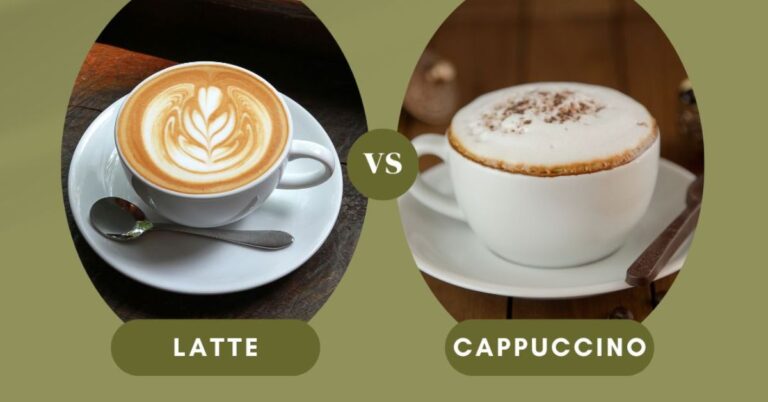In the world of coffee, the latte and cappuccino are two of the most beloved espresso-based drinks. Both offer unique flavors and textures, but they cater to different preferences. Whether you’re a seasoned coffee aficionado or just beginning your coffee journey, understanding the differences between a Latte vs Cappuccino can help you find your ideal brew. This article will explore the characteristics, preparation methods, and flavor profiles of both drinks to help you make an informed choice.
What is a Latte?
A latte, or “caffè latte,” originates from Italy and translates to “milk coffee.” It is renowned for its creamy texture and smooth flavor. A classic latte is made with a single or double shot of espresso, topped with steamed milk, and finished with a thin layer of milk foam. The ratio of milk to espresso is typically around 3:1, making it a milk-forward coffee drink.
Key Characteristics of a Latte
- Milk Ratio: The latte contains a higher proportion of steamed milk compared to espresso. This makes it a milder coffee drink with a rich, creamy texture. The generous amount of milk balances the strong flavor of the espresso, resulting in a smooth and mellow taste.
- Texture and Foam: A latte features a silky texture thanks to the steamed milk, which is gently mixed with the espresso. The milk foam on top is usually minimal, just enough to create a light, frothy layer that adds a touch of creaminess.
- Flavor Profile: The dominant flavor in a latte is the milk, which can be flavored with syrups or spices to create variations like vanilla or caramel lattes. The espresso flavor is present but not overpowering, making it a great choice for those who prefer a less intense coffee experience.
What is a Cappuccino?
The cappuccino, another Italian classic, is known for its balanced blend of espresso, steamed milk, and a generous amount of milk foam. It is named after the Capuchin friars, whose brown robes resemble the drink’s color. Unlike the latte, the cappuccino has a more even balance between espresso and milk, with a thicker layer of foam.
Key Characteristics of a Cappuccino
- Milk Ratio: A cappuccino typically has equal parts espresso, steamed milk, and milk foam. The traditional ratio is about 1:1:1. This balance creates a robust coffee flavor, complemented by the creamy milk and airy foam.
- Texture and Foam: The cappuccino is characterized by its thick, velvety foam that sits atop the espresso and steamed milk. This foam is made by frothing the milk until it reaches a dense, stable consistency. The foam adds a light, airy texture to the drink and helps to insulate the coffee, keeping it warm for longer.
- Flavor Profile: The cappuccino has a stronger espresso flavor compared to the latte, due to the equal ratio of espresso and milk. The foam contributes a creamy texture, while the lessened milk content ensures the coffee’s boldness shines through.
Preparing a Latte vs Cappuccino
While both drinks are made from espresso and milk, their preparation methods highlight their differences. Here’s a step-by-step guide on how to make each:
How to Make a Latte
- Brew the Espresso: Start by brewing a shot of espresso using your espresso machine. Ensure the coffee is freshly ground for the best flavor.
- Steam the Milk: Use a steam wand to froth the milk. Aim for a silky, smooth texture with only a small amount of foam. Heat the milk to around 150-160°F (65-70°C), but avoid overheating to prevent a burnt taste.
- Combine and Serve: Pour the steamed milk over the espresso, holding back the foam with a spoon. Add a thin layer of milk foam on top. You can also add flavored syrups or spices according to your preference.
How to Make a Cappuccino
- Brew the Espresso: Brew a shot of espresso as you would for a latte.
- Steam the Milk: Froth the milk using the steam wand until it reaches a thick, creamy foam. The milk should double in volume and have a velvety texture.
- Combine and Serve: Pour the espresso into a cup, then add an equal amount of steamed milk and foam. The foam should be thick enough to hold its shape and create a distinctive layer on top of the coffee.
Choosing Between a Latte and Cappuccino
Deciding between a latte and a cappuccino depends largely on your personal taste preferences and the coffee experience you’re seeking. Here are some considerations to help you choose:
- Milk Preference: If you enjoy a creamier, milk-forward drink, a latte may be more to your liking. Its higher milk content provides a smoother texture and a subtler coffee flavor.
- Bold Coffee Flavor: For those who prefer a stronger coffee taste with a richer foam, a cappuccino is the better choice. The balanced ratio of espresso to milk and the thick foam create a more pronounced coffee flavor.
- Texture and Foam: If you love a dense, frothy top layer, a cappuccino’s generous foam will appeal to you. On the other hand, if you prefer a lighter foam and a creamier drink, a latte is ideal.
- Customization: Both drinks can be customized with syrups, spices, and flavorings. However, the latte’s higher milk content allows for more flavor variations without overpowering the coffee.
Conclusion
Both the Latte vs Cappuccino offer unique coffee experiences that cater to different preferences. The latte’s creamy, milk-forward profile provides a smooth and mellow flavor, while the cappuccino’s balanced blend of espresso, milk, and thick foam delivers a stronger coffee taste and a satisfying texture. Understanding these differences can help you find your perfect brew, whether you’re seeking a rich, creamy drink or a bold, frothy coffee experience.

